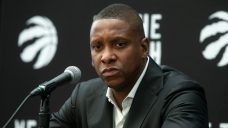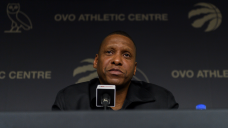Kawhi Leonard employs words sparingly, with a similar kind of economy and directness he uses to get to his preferred spots on the floor, from where he’s shown himself over and over to be one of the most effective post-season players in NBA history, at least when his body allows.
Nearly five years ago, at his introductory press conference in Toronto, where Leonard was last able to lead a team to a championship, he made one comment that resonated then and will likely resonate for the remainder of his star-crossed career, whatever form it takes.
“What are your goals?” he was asked by Toronto Star columnist Bruce Arthur. Leonard was established enough that he could have credibly aspired to anything: winning multiple MVP awards, setting records, striving to be the greatest two-way player – and maybe the greatest player, period – the league had ever seen.
But it was telling that even after having just turned 27 and living in a body that – from the outside, at least – seemed super-hero levels of invincible, Leonard’s goals were far more basic and, as it is turning out, harder to achieve.
“Just to be healthy,” he said then. “I mean, that’s my No. 1 goal. Play a long, dominant career and be able to be dominant wherever I land, and that’s about it. (And) I want to win championships, get in those record books.”
Fans are hoping Leonard’s career far from over. He’s still shy of his 32nd birthday and he showed this season that his ability to dominate games and lead teams and come out on top in duels with some of the best players in basketball history remains nearly unmatched.
But those hopes have to be a little dimmer today than they were last year and the year before that, and certainly compared even with 2018-19, when Leonard led the Toronto Raptors on a magical championship run.
It was reported Wednesday just hours after the Los Angeles Clippers had been eliminated from the first round of the playoffs with Leonard once again sidelined that the oft-injured star had suffered a torn meniscus in his left knee, the same knee in which he’d torn his ACL during the 2020-21 playoffs, causing him to miss the entire following season, and the same knee in which quadriceps tendinopathy cost him all but nine regular-season games in 2017-18 and ultimately led to him leaving San Antonio for Toronto.
It's in some ways even more frustrating and maybe even tragic for all involved. Leonard was his old self in Games 1 and 2 against the Phoenix Suns, which is to say, arguably the best player in the world, as he averaged 34.5 points a game while shooting 54.5 per cent from the floor and 60 per cent from the three while ably defending Suns star Kevin Durant for long stretches. But knee pain kept him out of Games 3, 4 and 5.
It's hard not to wonder if Leonard’s seemingly perfect basketball physique will prevent him from reaching the peaks he’s shown himself capable of, that his greatest gift will end up being his recurring curse.
Before the news of the torn cartilage came out, Leonard was loudly criticized for being hurt again. That’s twice in the past three years that a knee injury has ended his post-season. He’s lost two full regular seasons in the last five. Be it whispers or shots, those who don’t know any better – with ESPN talking head Stephen A. Smith at the front of the line – have questioned Leonard’s desire to play, his pain tolerance and his viability as a franchise player.
“I’m not in any way questioning the legitimacy of Kawhi Leonard’s injury,” Smith said Wednesday morning, although he’d certainly toed that line earlier in the week. “But he is the absolute worst superstar you could possibly have on your team. He’s barely ever there. And on top of it all, he does nothing to market or promote your franchise. ... Steve Ballmer and the Los Angeles Clippers should force Kawhi Leonard to retire.”
There are no indications that Leonard, who has two years and $95 million left on his contract, is planning to retire. If he and his running mate Paul George – who missed the last part of the regular season and the playoffs with a sprained right knee – can arrive at training camp in good health, chances are the Clippers will remain one of the teams to beat in the West and a championship contender.
One can hope. But as someone who covered Leonard during his last championship run, it’s a big mistake to question his will or desire, not that it’s ever good policy to question any athlete’s injury.
Leonard showed plenty in his one season in Toronto to convince anyone who actually pays attention that he’s a gamer, someone who lives to lose themselves in competition. To the extent he’s careful and cautious, it’s between games because he understands his limits and the load he carries when seasons hang in the balance. He might treat the regular season as “82 practices” as he famously said, but doubting his determination when the stakes are at their highest simply means you’re not paying attention.
Even in the one virtually perfect season in Toronto, there were plenty of moments when it almost didn’t happen.
There was how it started, when the initial reports after he was traded from the San Antonio Spurs were that he was unhappy he hadn’t been sent to Los Angeles, and that he might not report to the Raptors. There was also concern that after appearing in just nine games for the Spurs in 2017-18 due to a persistent problem with his quadriceps tendon in his left knee, he might not be able to play a full season, or at the MVP level he’d established in 2016-17, his last healthy campaign in San Antonio.
Even when he arrived in Toronto and all systems were go, there were questions about his durability. Leonard was the first – or at least most high-profile – NBA player who had his game-to-game availability doled out in increments under what became known as a "load management" protocol. He didn’t play back-to-back games to start the season and, as the year went on, it became evident he simply wouldn’t. He was shut down for a week after scoring 41 points in a season-high 45 minutes in a double-overtime win over the Washington Wizards on Jan. 13.
And even when Leonard was in full flight and putting together one of the most dominant playoff runs the NBA had ever seen, culminating in his second Finals MVP award, there were doubts.
On the morning of May 20, 2019, Leonard’s knee was sore, mind you there was good reason: With the Raptors trailing 2-0 in the Eastern Conference Finals against the Milwaukee Bucks, Leonard had given everything he had the day before to help Toronto survive an epic double-overtime and win Game 3. He played 52 minutes and scored 19 of his 36 points in the fourth quarter and overtime periods. But in that game, a limp became apparent. He'd tweaked something but somehow powered through.
The Raptors sent him for an MRI on the off day before Game 4 and gave him the option of sitting it out. He was a pending free agent, and as much as Toronto believed a title was within its grasp, having Leonard risk his long-term health wasn’t part of the plan.
But Leonard wasn’t having it. “I’m playing,” he said.
He wasn’t nearly himself in Game 4. He played just 34 minutes – five fewer than his playoff average that year – and was, by his standards, relatively passive. He took just 13 shots, which was his lowest total for the 24 playoff games he played on his way to the title, other than the 11 he took in a blowout first-round clinching win over Orlando in the first round.
But his presence made all the difference. Bucks head coach Mike Budenholzer – to his detriment – had Leonard defended like he was coming off three days’ rest, showing him multiple defenders at every turn. The extra space allowed Norm Powell and Fred VanVleet to load up, and they combined to shoot 7-of-16 from deep, which ended up being the difference in the game. The series was tied, and the Raptors never looked back, surging past the Bucks in six games and using six more to outlast the Warriors in the Finals.
But was Leonard ever fully healthy again in the Raptors' run? It’s hard to know, but in 14 games before the triple-overtime marathon, Leonard was averaging 31.7 points a game with an effective field-goal percentage of 57.9. In the next nine games, he averaged 28 points a game with an eFG of 49.7.
Leonard did a lot of things in his one magical season in Toronto, and it was hard to get behind the curtain. He was on his own program and under the careful supervision of the Raptors director of sports science, Alex McKechnie. The mystery around how he was being handled and Leonard’s largely inscrutable nature made for some awkwardness as the season unfolded and the Raptors tried to get a read on their new teammate.
“All right, he’s resting,” was how VanVleet explained the mood in 2019. “But what the hell is he resting for?”
It all became clear as Leonard lifted the Raptors on his impossibly broad shoulders and carried them up the mountain, managing the load like few ever could.
It was a sight to behold, and a nation watched nearly every minute in awe.
Once you’ve seen Leonard at his best, you simply have to understand that if he is physically able to play at the level he demands of himself, he will, and it’s one of the greatest spectacles in basketball.
If he can’t, he won’t. The one thing Leonard can’t do on a basketball court is make himself injury free.
All the Clippers can do is wait. Maybe it will be next year, or the year after that. Presuming Leonard is physically able, it will be worth it.


























COMMENTS
When submitting content, please abide by our submission guidelines, and avoid posting profanity, personal attacks or harassment. Should you violate our submissions guidelines, we reserve the right to remove your comments and block your account. Sportsnet reserves the right to close a story’s comment section at any time.